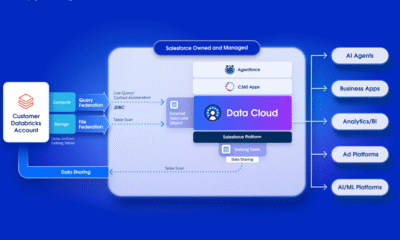Jobs & Careers
Databricks Names Kamalkanth Tummala as India Country Manager, Strengthens $250 Mn Investment Plan

Databricks, on September 15, appointed Kamalkanth Tummala as its new country manager for India, a move that comes as part of the company’s $250 million investment to expand operations, research and go-to-market resources in the country.
Tummala, who previously served as vice president at Salesforce, will lead Databricks’ growth strategy in India. He will take charge of scaling the company’s local business and strengthening its presence across industries.
“We’re excited to welcome Kamal to our leadership team as we expand in India—one of our most dynamic and strategic growth markets,” said Ed Lenta, senior vice president and general manager, Asia Pacific and Japan at Databricks. “Leading organisations such as CommerceIQ, Freshworks, HDFC Bank, Swiggy, TVS Motors and Zepto already rely on Databricks to innovate with data and AI. Now, with Kamal on board and our continued investment in India, we are well-positioned to build on this momentum.”
Tummala said his focus will be on accelerating enterprise adoption of Databricks’ data and AI platforms. “In India’s dynamic landscape, data and AI are reshaping every organisation and Databricks is uniquely positioned to help enterprises build a lasting competitive advantage,” he said. “I look forward to working with our customers and partners to accelerate their AI journeys.”
Tummala brings over 20 years of experience in enterprise technology and leadership. At Salesforce, he led go-to-market initiatives across multiple industries. Before that, he spent nearly a decade at Mindtree Ltd as regional director in India, where he expanded strategic accounts.
Databricks has expanded significantly in India in recent years. The company has increased regional hiring, opened a 1,05,000-square-foot R&D office in Bengaluru and launched the India Data + AI Academy.
The company will also host its Data + AI World Tour 2025 in Mumbai on September 19, featuring industry leaders, customers and partners showcasing data and AI solutions.
Jobs & Careers
Nagaland University Brings Fractals Into Quantum Research

Nagaland University has entered the global quantum research spotlight with a breakthrough study that brings nature’s fractals into the quantum world.
The work, led by Biplab Pal, assistant professor of physics at the university’s School of Sciences, demonstrates how naturally occurring patterns such as snowflakes, tree branches, and neural networks can be simulated at the quantum scale.
Published in the peer-reviewed journal Physica Status Solidi – Rapid Research Letters, the research could influence India’s National Quantum Mission by broadening the materials and methods used to design next-generation quantum devices.
Fractals—repeating patterns seen in coastlines, blood vessels, and lightning strikes—have long fascinated scientists and mathematicians. This study uses those self-similar structures to model how electrons behave under a magnetic field within fractal geometries. Unlike most quantum device research that relies on crystalline materials, the work shows that non-crystalline, amorphous materials could also be engineered for quantum technologies.
“This approach is unique because it moves beyond traditional crystalline systems,” Pal said. “Our findings show that amorphous materials, guided by fractal geometries, can support the development of nanoelectronic quantum devices.”
The potential applications are wide-ranging. They include molecular fractal-based nanoelectronics, improved quantum algorithms through finer control of electron states, and harnessing the Aharonov-Bohm caging effect, which traps electrons in fractal geometries for use in quantum memory and logic devices.
University officials called the study a milestone for both Nagaland University and India’s quantum research ecosystem. “Our research shows a new pathway where naturally inspired fractal geometries can be applied in quantum systems,” vice-chancellor Jagadish K Patnaik said. “This could contribute meaningfully to the development of future quantum devices and algorithms.”
With this study, Nagaland University joins a small group of Indian institutions contributing visibly to international quantum research.
Jobs & Careers
The Lazy Data Scientist’s Guide to Time Series Forecasting


Image by Editor | ChatGPT
# Introduction
Time series forecasting is everywhere in business. Whether you’re predicting sales for next quarter, estimating inventory demand, or planning financial budgets, accurate forecasts can make — or break — strategic decisions.
However, classical time series approaches — like painstaking ARIMA tuning — are complicated and time-consuming.
This presents a dilemma for many data scientists, analysts, and BI professionals: precision versus practicality.
That’s where a lazy data scientist’s mindset comes in. Why spend weeks fine-tuning models when modern Python forecasting libraries and AutoML can give you an adequate solution in less than a minute?
In this guide, you’ll learn how to adopt an automated forecasting approach that delivers fast, reasonable accuracy — without guilt.
# What Is Time Series Forecasting?
Time series forecasting refers to the process of predicting future values derived from a sequence of historical data. Common applications include sales, energy demand, finance, and weather, among others.
Four key concepts drive time series:
- Trend: the long-term tendency, shown by increases or decreases over an extended period.
- Seasonality: patterns that repeat regularly within a year (daily, weekly, monthly) and are associated with the calendar.
- Cyclical: repeating movements or oscillations lasting more than a year, often driven by macroeconomic conditions.
- Irregular or noise: random fluctuations we cannot explain.
To further understand time series, see this Guide to Time Series with Pandas.


Image by Author
# The Lazy Approach to Forecasting
The “lazy” approach is simple: stop reinventing the wheel. Instead, rely on automation and pre-built models to save time.
This approach prioritizes speed and practicality over perfect fine-tuning. Consider it like using Google Maps: you arrive at the destination without worrying about how the system calculates every road and traffic condition.
# Essential Tools for Lazy Forecasting
Now that we have established what the lazy approach looks like, let’s put it into practice. Rather than developing models from the ground up, you can leverage well-tested Python libraries and AutoML frameworks that will do most of the work for you.
Some libraries, like Prophet and Auto ARIMA, are great for plug-and-play forecasting with very little tuning, while others, like sktime and Darts, provide an ecosystem with great versatility where you can do everything from classical statistics to deep learning.
Let’s break them down:
// Facebook Prophet
Prophet is a plug-and-play library created by Facebook (Meta) that’s especially good at capturing trends and seasonality in business data. With just a few lines of code, you can produce forecasts that include uncertainty intervals, with no heavy parameter tuning required.
Here is a sample code snippet:
from prophet import Prophet
import pandas as pd
# Load data (columns: ds = date, y = value)
df = pd.read_csv("sales.csv", parse_dates=["ds"])
# Fit a simple Prophet model
model = Prophet()
model.fit(df)
# Make future predictions
future = model.make_future_dataframe(periods=30)
forecast = model.predict(future)
# Plot forecast
model.plot(forecast)
// Auto ARIMA (pmdarima)
ARIMA models are a traditional approach for time-series predictions; however, tuning their parameters (p, d, q) takes time. Auto ARIMA in the pmdarima library automates this selection, so you can obtain a reliable baseline forecast without guesswork.
Here is some code to get started:
import pmdarima as pm
import pandas as pd
# Load time series (single column with values)
df = pd.read_csv("sales.csv")
y = df["y"]
# Fit Auto ARIMA (monthly seasonality example)
model = pm.auto_arima(y, seasonal=True, m=12)
# Forecast next 30 steps
forecast = model.predict(n_periods=30)
print(forecast)
// Sktime and Darts
If you want to go beyond classical methods, libraries like sktime and Darts give you a playground to test dozens of models: from simple ARIMA to advanced deep learning forecasters.
They’re great for experimenting with machine learning for time series without needing to code everything from scratch.
Here is a simple code example to get started:
from darts.datasets import AirPassengersDataset
from darts.models import ExponentialSmoothing
# Load example dataset
series = AirPassengersDataset().load()
# Fit a simple model
model = ExponentialSmoothing()
model.fit(series)
# Forecast 12 future values
forecast = model.predict(12)
series.plot(label="actual")
forecast.plot(label="forecast")
// AutoML Platforms (H2O, AutoGluon, Azure AutoML)
In an enterprise environment, there are moments when you simply want forecasts without having to code and with as much automation as possible.
AutoML platforms like H2O AutoML, AutoGluon, or Azure AutoML can ingest raw time series data, test several models, and deliver the best-performing model.
Here is a quick example using AutoGluon:
from autogluon.timeseries import TimeSeriesPredictor
import pandas as pd
# Load dataset (must include columns: item_id, timestamp, target)
train_data = pd.read_csv("sales_multiseries.csv")
# Fit AutoGluon Time Series Predictor
predictor = TimeSeriesPredictor(
prediction_length=12,
path="autogluon_forecasts"
).fit(train_data)
# Generate forecasts for the same series
forecasts = predictor.predict(train_data)
print(forecasts)
# When “Lazy” Isn’t Enough
Automated forecasting works very well most of the time. However, you should always keep in mind:
- Domain complexity: when you have promotions, holidays, or pricing changes, you may need custom features.
- Unusual circumstances: pandemics, supply chain shocks, and other rare events.
- Mission-critical accuracy: for high-stakes scenarios (finance, healthcare, etc.), you will want to be fastidious.
“Lazy” does not mean careless. Always sanity-check your predictions before using them in business decisions.
# Best Practices for Lazy Forecasting
Even if you’re taking the lazy way out, follow these tips:
- Always visualize forecasts and confidence intervals.
- Compare against simple baselines (last value, moving average).
- Automate retraining with pipelines (Airflow, Prefect).
- Save models and reports to ensure reproducibility.
# Wrapping Up
Time series forecasting does not need to be scary — or exhaustive.
You can get accurate, interpretable forecasts in minutes with Python forecasting libraries like Prophet or Auto ARIMA, as well as AutoML frameworks.
So remember: being a “lazy” data scientist does not mean you are careless; it means you are being efficient.
Josep Ferrer is an analytics engineer from Barcelona. He graduated in physics engineering and is currently working in the data science field applied to human mobility. He is a part-time content creator focused on data science and technology. Josep writes on all things AI, covering the application of the ongoing explosion in the field.
Jobs & Careers
How to Build Production-Ready UI Prototypes in Minutes Using Google Stitch

 Image by Author | Canva
Image by Author | Canva# Introduction
What usually happens during app development is that you and your team finalize a design, go through development and testing, and when it’s finally time to review what you’ve been building for weeks, it just feels off. It either looks underdeveloped or simply “not right.” Too many iterations, too much time, and somewhere along the way, the original idea gets lost.
To solve this, Google introduced a new tool called Google Stitch. You just give simple English commands and get a beautiful, responsive, production-ready prototype you can deploy. And the best part? It’s free to try at stitch.withgoogle.com. In this article, I’ll walk you through my experience using Google Stitch and teach you how to get started too.
# Getting Started with Google Stitch
Head over to stitch.withgoogle.com and sign in with your Google account before starting.
// 1. Choose Your Mode
From the top-right corner of the screen, you can switch between the following modes:
- Standard Mode (Gemini 2.5 Flash): Best for quick drafts and MVPs.
- Experimental Mode (Gemini 2.5 Pro): Lets you generate UI from image inputs, wireframes, or sketches that you can upload for inspiration.
// 2. Describe or Upload
You’ll see a prompt box with a canvas next to it.
- Text prompt example: “A signup form page with logo at top, email/password fields, submit button in primary color.”
- Image prompt (Experimental): Upload a wireframe or screenshot to guide the generation alongside your text.
For instance, I used Standard Mode and gave the following prompt:
“Quiz page in a language learning app with a progress bar at the top. The title challenges you to match an Urdu word with the correct answer, offering four possible options.”
It generated an amazing UI based on this:


// 3. Preview and Tweak
Use the sidebar to adjust themes: change color palettes, fonts, border radius, and switch between dark and light mode. Google Stitch also lets you modify designs using updated prompts.
For example, I updated the theme to dark and changed the font to Manrope. After clicking Apply Theme, the output looked even more polished:


// 4. Iterate Smartly
You can refine individual components or screens. For example:
- “Make the primary button bigger and blue.”
- “Add a navigation bar to the top of the homepage.”
Stitch follows your step-by-step instructions very accurately. In my case, the Urdu words initially appeared as romanized text. So I updated the prompt:
“Display the Urdu word in a right-to-left direction with a large Nastaliq-style font, centered on the screen.”
The result was genuinely impressive:


// 5. Export and Build
You can click on the generated image to copy the code, or hit Paste to Figma to drop editable, auto-layout artboards directly into your design workspace.
Here’s what showed up when I clicked on the image and selected Copy Code. It was instantly ready to integrate into a dev environment or a design file.


# Final Thoughts and Getting the Best Results
Although it’s not a complete design solution, Google Stitch is highly recommended for MVPs and early-stage development. You can always export to Figma for advanced design customization or to build multi-screen logic.
Here are a few tips for getting better results:
- Use UI-specific language like “navbar,” “dashboard widgets,” “primary button,” or “auto-spacing” to guide the structure more accurately.
- Start with a high-level description and refine it step-by-step. For example: “fitness tracking app.”
- Be very specific when editing. Mention elements clearly, such as “change the color of the primary button on the signup form to white.”
Google Stitch is fast, intuitive, and gives you a great starting point when you need working prototypes without getting stuck in weeks of back-and-forth. Definitely worth trying.
Kanwal Mehreen is a machine learning engineer and a technical writer with a profound passion for data science and the intersection of AI with medicine. She co-authored the ebook “Maximizing Productivity with ChatGPT”. As a Google Generation Scholar 2022 for APAC, she champions diversity and academic excellence. She’s also recognized as a Teradata Diversity in Tech Scholar, Mitacs Globalink Research Scholar, and Harvard WeCode Scholar. Kanwal is an ardent advocate for change, having founded FEMCodes to empower women in STEM fields.
-

 Business3 weeks ago
Business3 weeks agoThe Guardian view on Trump and the Fed: independence is no substitute for accountability | Editorial
-
Tools & Platforms1 month ago
Building Trust in Military AI Starts with Opening the Black Box – War on the Rocks
-

 Ethics & Policy2 months ago
Ethics & Policy2 months agoSDAIA Supports Saudi Arabia’s Leadership in Shaping Global AI Ethics, Policy, and Research – وكالة الأنباء السعودية
-

 Events & Conferences4 months ago
Events & Conferences4 months agoJourney to 1000 models: Scaling Instagram’s recommendation system
-

 Jobs & Careers3 months ago
Jobs & Careers3 months agoMumbai-based Perplexity Alternative Has 60k+ Users Without Funding
-

 Podcasts & Talks2 months ago
Podcasts & Talks2 months agoHappy 4th of July! 🎆 Made with Veo 3 in Gemini
-

 Education3 months ago
Education3 months agoVEX Robotics launches AI-powered classroom robotics system
-

 Education2 months ago
Education2 months agoMacron says UK and France have duty to tackle illegal migration ‘with humanity, solidarity and firmness’ – UK politics live | Politics
-

 Podcasts & Talks2 months ago
Podcasts & Talks2 months agoOpenAI 🤝 @teamganassi
-

 Funding & Business3 months ago
Funding & Business3 months agoKayak and Expedia race to build AI travel agents that turn social posts into itineraries











